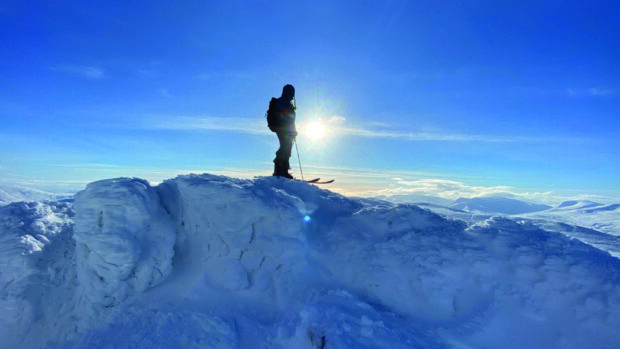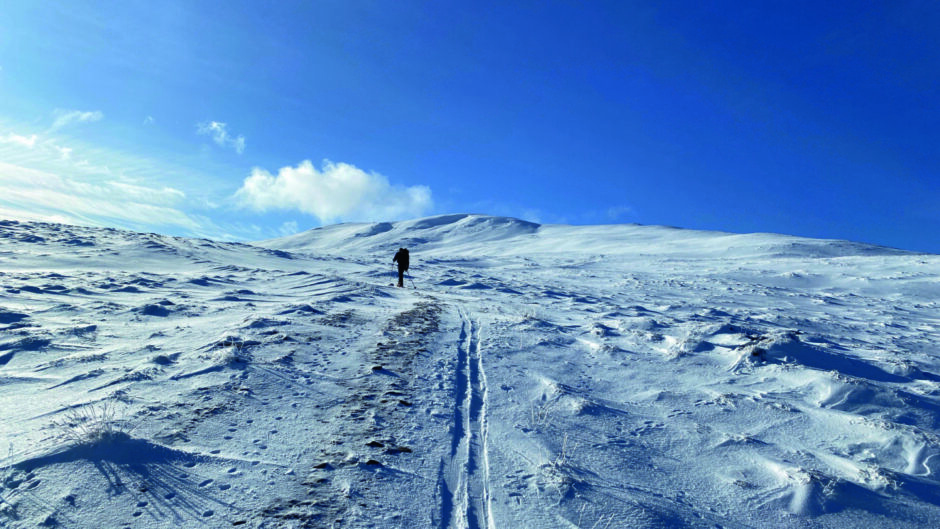
Sometimes there is too much choice in Scotland’s huge outdoors playground – and, as my husband Gordon and I looked at the ground at the start of our ski touring location, we questioned our decision.
The snow was at least a week old, there were many visible clumps of heather and, while we welcomed the sun, it revealed patches of glistening ice.
However, thanks to our wide experience of Scottish winter pursuits, we believed that the mountain, The Fara, still had potential to give us a great ski touring trip.
We started the outing on a wide track, heading west, from the side of the A889, just north of Dalwhinnie. At first, the snow was patchy on the trail, but within around 90 metres (300 feet), it thickened and we were making speedy progress on a gentle uphill gradient through trees.
Touring skis – also known as backcountry skis – have become increasingly popular. They offer a much greater versatility compared to “downhill only” skis and avoid the need for mechanical uplift, such as by gondola or chairlift.
Traction on snowy slopes is provided by “skins”, which are long strips of fabric attached to the base of the skis. The ski boots unclip at the heels so tourers can step-slide forwards, while also using hand-held ski poles to push.
In Scotland, touring skis offer an amazing freedom to journey to many places where people might walk in the warmer seasons. The pace can be faster than on foot, too.
After almost a kilometre (around half a mile) the track met a fence line and we spotted the ski lines of someone else. We checked the map to confirm they’d headed in the right direction and happily jumped into the tracks – it’s often easier to ski where others have been before.
Sadly, at the end of the fence, the tracks mysteriously disappeared – leaving Gordon and I to take it in turns to break trail on a steeper slope.
The snow was becoming thicker, but occasional bulges of soft heather caught the front tip of our skis if we weren’t paying attention. Several times, one of us was thrown off-balance – but at least the landing was soft!
Scottish skiing requires technical skills and fitness – as well as an ability to see the funny side when conditions are far from perfect.
Yet, for most of the climb, we found the going relatively easy and could ski mostly straight uphill. Stopping to catch our breath, we enjoyed the ever-expanding views of a stunning white landscape.
Just below the summit ridge, the gradient increased and we swapped to zigzagging across the slope, to maintain momentum uphill. Our tracks created stark lines on an otherwise untouched blanket of snow.
There is a large cairn on the summit of The Fara and, a little further south, high slabs of rock where the true top is measured. These were covered in huge clusters of ice.
At 911m (2,988ft) the mountain is just a dozen feet shy of being a Munro and instead sits in the list of 221 Corbetts.
Gordon and I stopped for a while to sit in the winter sun, sipping sweet tea and eating flapjacks. The vista included numerous mountain peaks and we identified those of Ben Alder in the south-west and Creag Meagaidh to the west. Far below, we saw the waters of Loch Ericht.
It’s possible to continue along the ridge for just over 3km (two miles) south-west, but we knew the weather was forecast to change and so chose to take a shorter descent.
This was the part of the adventure we’d been looking forward to.
After removing the skins, then carefully skiing windswept and icy snow higher up, we came across the most perfect powder snow on an eastern flank.
It was so good that we decided it would be worth reattaching the skins to return back uphill so we could enjoy the fluffy snow again.
On our second descent, the clouds crept in around us and the brighter light faded.
Skiing in flat light can be a bit tricky so we continued downhill this time.
We had wondered earlier if we would be able to ski back to the roadside and, while this required plenty of dexterity – including many sharp turns to avoid rocks, plus a fair amount of heather and grassy tussock bashing and some upper body propulsion – we did just that.
Into the wild: fionaoutdoors.co.uk

Enjoy the convenience of having The Sunday Post delivered as a digital ePaper straight to your smartphone, tablet or computer.
Subscribe for only £5.49 a month and enjoy all the benefits of the printed paper as a digital replica.
Subscribe
